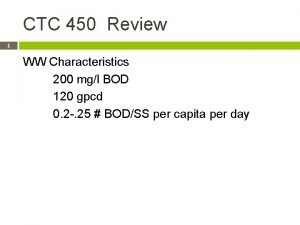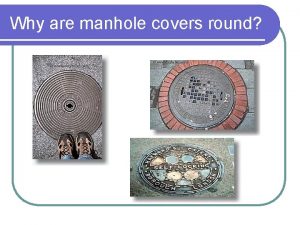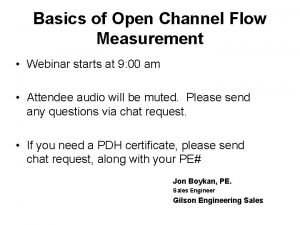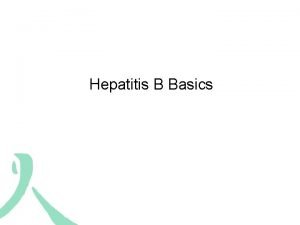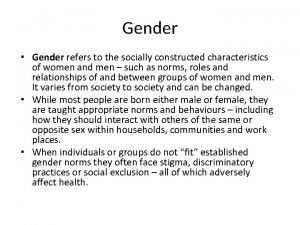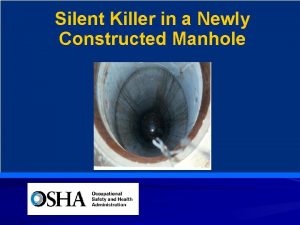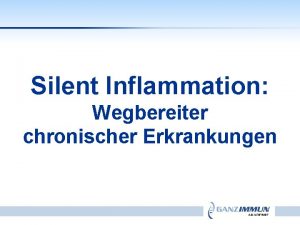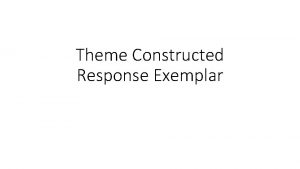Silent Killer in a Newly Constructed Manhole Reason











- Slides: 11

Silent Killer in a Newly Constructed Manhole

Reason For the Intervention • OSHA received notification of a construction site fatality on August 5, 2004 – day following the incident • Reported that the employee was found at the bottom of a manhole • New sewer system under construction - SIC Code 1623

The Site • Company laying sewer pipe & manholes for a new housing development • 6 employees onsite • Farm land; slightly hilly; slope of ground ~ 1 to 4 • Manhole was adjacent to an entrance ramp to a highway

• 2 foot opening • 4 foot wide internal diameter • Riser was constructed of 4’ X 4’ concrete pipe sections • 17 feet deep outside 161/2 feet inside • Two 8” PVC Pipes in the bottom • Built on a 4” to 12” bed of limestone chat

Code Requirements City codes require a vacuum test – must maintain 10 inches of mercury for a specific time based on depth of manhole If vacuum test fails, then sections of the manhole must be grouted to get a better seal

The Incident • After vacuum test failure, employee reportedly was assigned the grouting task • Grouting is done by hand takes about 1 hour • The employee was working alone • The employee was found at the bottom of the manhole unconscious

Manhole Conditions • After Inspection Activity recovery, the medical examiner requested sampling of manhole • Fire Department – Haz Mat Division took some multi-gas readings about 3 hours after recovery • Results were 16. 3 to 17% for oxygen and 0. 0 here to 4. 5 % Picture goes LEL • Zero readings for carbon monoxide and hydrogen sulfide • No readings taken for carbon dioxide

Inspection Activity • The employer did not have a confined space entry program • OSHA’s Salt Lake City Technical Center Health Response Team assisted with site analysis • Direct Reading Instruments results 9 days later revealed: • Oxygen – 16. 0 to 18. 2 % • CO 2 – 1. 8 to 3. 5 % or 18, 000 to 35, 000 PPM • LEL – 5 to 8 %

Inspection Activities (cont. ) • Grab or bulk air samples taken with a medium flow pump at 3 L/Min. • Collected in aluminum bags • Lab results as follows: • Oxygen – 12. 5 to 14. 1 % • CO 2 – 16, 845 to 23, 968 PPM • Methane – 776 to 1372 PPM

Carbon Dioxide Colorless odorless gas – Displaces oxygen leading to oxygen deficiency Special problem in Midwest area – Limestone Rock Calcium Carbonate – Acidic topsoil – Acid leaches from soil, which then contacts the limestone producing Carbon Dioxide Numerous fatalities – Especially in new sewer/vault leak testing using a vacuum – Pulls carbon dioxide into the space Oxygen measured at less than 3% on other similar fatalities 5 similar cases known Nation-wide since 2000; 2 cases with 4 fatalities in the Kansas City area

Oxygen Deficient Atmospheres 19. 5 % 15 - 19% 12 -14% 10 -12% 8 -10% 6 -8% 4 -6% Minimum acceptable oxygen level. Decreased ability to work strenuously. Impair coordination. Early symptoms. Respiration increases. Poor judgment. Respiration labored. Lips blue. Mental failure. Fainting, Nausea, Unconsciousness, Vomiting. 4 -5 minutes - possible recovery, 6 minutes - 50% fatal, & 8 minutes fatal. Coma almost instantaneously. Death
